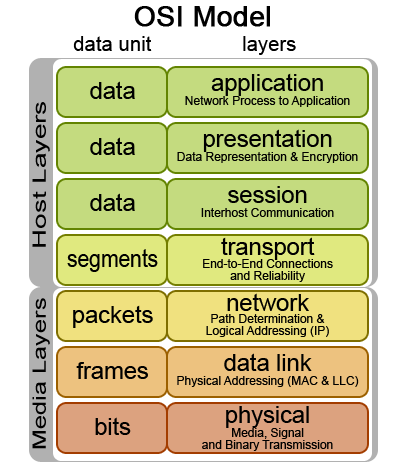
Figure 1: The OSI Model
Typically, when students start creating their logical diagram, if they include logical configuration information at all, they always seem to focus on the internal side of this connection; the LAN side. But there is the WAN side of this connection as well. What kind of configuration information is on the WAN side of the connection? It (hopefully) obviously needs an IP address. Just to make this clear, every device connected to the Internet needs a unique IP address in order to be able to communicate with other devices over the Internet. The WAN connection also needs a subnet identified. The subnet is important because it tells the router on the WAN side of the connection which part of the IP address refers to the network and which part refers to the router itself (on the WAN side). The WAN side also needs a default gateway. If the router does not know where to route a particular packet, it needs the default gateway to forward the packet to a higher layer router that may in fact know where that particular packet should be sent. Lastly, the WAN side of the connection needs to know a DNS server so that it can resolve domain names and share that information with clients on the LAN side.
Now, the good news is that while you need to know how to configure these settings, you do not have to come up with the numbering scheme itself. If you have a static connection, this information will be provided to you by your ISP. This is typically the case for business class services in which you need your external address to stay the same so that web server, email servers, and so on can routinely be found in the same place logically. Consumers typically have dynamic addresses and this really makes things easy as the router reaches out to the ISP and obtains this information automatically. The advantage of this is obviously that it reduces your administrative burden.
Figure 2 below shows a router where the WAN port is labeled 'Line' and then it also happens to have a four port switch built into the router, with each port labeled 1 through 4. So, the WAN configuration information is associated with the WAN or 'Line' side of the router whereas the LAN side of the configuration information is associated with the clients associated with the four ports.

Figure 2: Router
On the internal side of the network, we also have configuration information that is needed. Specifically, we need an IP address and a subnet mask to tell the router which portion of the IP address represents the network and which part represents the router itself. The IP address serves as the default gateway for all the clients on the internal side of the network. Where is the rest of the configuration information internally? It's not there. When a client on the internal side of the network does not know where the server is that it is trying to communicate with, it sends the packet to its default gateway which is found in its own configuration information. That gateway is the router's LAN connection. When the router gets that request, if the requested server is not on the LAN side of the connection, it routes the packet to the WAN side of the connection which includes a default gateway so that it knows where to forward the packet.
Figure 3 illustrates a sample logical diagram. In this diagram, for the gateway router, you should see that the WAN connection is dynamically set. Again, this makes it easy on the network administrator. Internally, there is an IP address and a Subnet Mask (SM). There is also an SSID to indicate that this is also a wireless router as well as information indicating that this wireless router is capable as serving as a DHCP server.
Figure 3: Logical Diagram
You may also notice a second, internal router is included in the diagram. This design is segmenting the network at layer 3. I want to draw your attention to the WAN side of the internal router. It includes the IP address and the default gateway. Specifically, I want to draw your attention to the IP address and the fact that it is on the same subnet as the internal side of the gateway router. This is necessary so that the two routers can communicate. Also, note the internal IP address of the internal router. Note that it is on a different subnet. As a result, it can be said that this network is segmented to keep traffic from the business side of the network separate of the traffic on the personal side of the network.
So, that is what a router is and some basic information about the configuration information that goes into a router and whatnot. Commercial routers get much more complicated quickly. But, at the same time, commercial routers are beginning to take on similar dashboards to consumer grade routers making them easier to configure and use. If you have any questions, please leave a comment. Follow me on Twitter @SchuesslerPhD and until next time, happy networking.
Dr. S.
